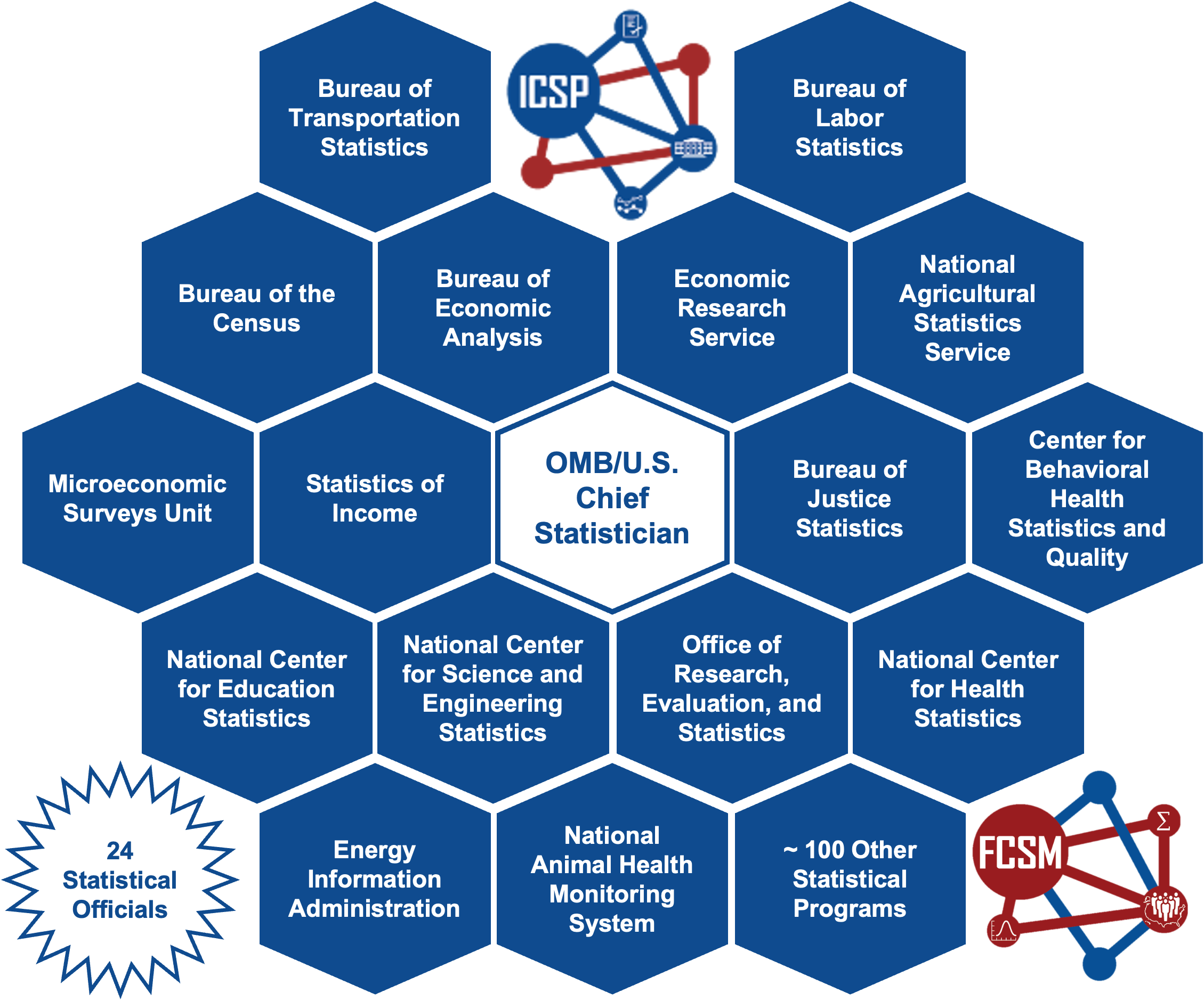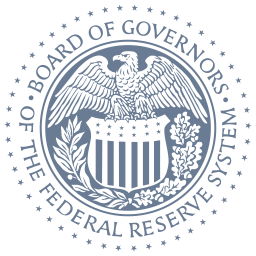About Us
The Federal Statistical System
Relevant, timely, credible, and objective statistical information is part of the foundation of democracy and the fundamental responsibility of the U.S. Federal statistical system. Since the Nation's founding, the U.S. Federal statistical system has collected and transformed data into high quality statistical information, making it readily available to inform all types of decision-making, while protecting the responses of individual data providers. Such decisions may include those made by Federal, state, local, territorial, and tribal policymakers; the private sector, including businesses; and individuals. Led by the U.S. Chief Statistician, OMB, and the Interagency Council on Statistical Policy (ICSP), the U.S. Federal statistical system is a decentralized, interconnected network of 16 Recognized Statistical Agencies and Units, 24 Statistical Officials (across 24 major cabinet agencies), approximately 100 additional Federal statistical programs engaged in statistical activities, and several cross system interagency and advisory bodies.
The vision of the Federal statistical system is to operate as a seamless system, as stewards of much of the nation's most sensitive data, enabling greater evidence building, civic engagement, and public and private sector decision making.
This graphic depicts each of the entities as part of the decentralized, interconnected network that is the Federal statistical system.


Office of Management and Budget and the U.S. Chief Statistician
The Office of Management and Budget (OMB), via the U.S. Chief Statistician, leads and coordinates the decentralized U.S. Federal statistical system, along with the ICSP. The U.S. Chief Statistician is assisted by statistical policy staff within OMB's Office of Information and Regulatory Affairs. The U.S. Chief Statistician and leaders of the statistical system are working together to provide strategic vision and robust implementation in support of the U.S. Federal statistical system's critical longstanding — and expanding — role for supporting evidence-based decision-making. The responsibilities of the U.S. Chief Statistician and OMB, derived from statutes — including the Paperwork Reduction Act of 1995 (PRA) and the Foundations for Evidence-Based Policymaking Act of 2018 (Evidence Act) — include:
- Coordinating the activities of the U.S. Federal statistical system to ensure the efficiency and effectiveness of the system and the integrity, objectivity, impartiality, utility, and confidentiality of information collected for statistical purposes
- Ensuring that agencies' budget proposals are consistent with U.S. Federal statistical system priorities
- Developing and implementing United States government-wide statistical policies, principles, standards, guidelines, and regulations, including those required by the Evidence Act, to bolster trust in the U.S. Federal statistical system, enhance the ability of statistical agencies and units to acquire Federal data for statistical purposes, and promote the expansion of safe and secure access to protected statistical data
- Evaluating statistical program performance and agency compliance with policies, principles, standards, guidelines, and regulations
- Approving statistical agency information collections and regulations
- Promoting the sharing of statistical information, consistent with privacy rights and confidentiality pledges
- Coordinating United States participation in international statistical activities, including the development of comparable statistics, and also representing the United States as a member of the United Nations Statistical Commission, among other international bodies
- Chairing the ICSP and working with other interagency councils to promote U.S. Federal statistical system priorities and to facilitate statistical functions and activities
- Providing opportunities for training in statistical policy functions to employees of the Federal Government

Interagency Council on Statistical Policy
Started in 1989, the Interagency Council on Statistical Policy (ICSP) was originally created to improve communication among the heads of the principal statistical agencies, and later was charged with advising and assisting the U.S. Chief Statistician and the Office of Management and Budget. The Evidence Act expanded membership to include the newly established Statistical Officials across major cabinet agencies, 11 of which are also heads of statistical agencies. The ICSP, led by the U.S. Chief Statistician, supports implementation of the statistical system's vision to operate as a seamless system, working together to provide strategic vision and robust implementation in support of the U.S. Federal statistical system's critical longstanding — and expanding — role for supporting evidence-based decision-making. For example, the ICSP sets strategic goals for modernizing the statistical system, as well as enhancing coordination and collaboration across the system, recognizing the efficiencies and advancements possible when taking advantage of the whole system's statistical infrastructure and expertise.
The ICSP also charters subcommittees, as well as sponsoring leadership, mentorship, and awards programs. Some examples include:
- ICSP Charter
- ICSP Subcommittee - the American Community Survey
- ICSP Subcommittee - Federal Statistical Research Data Centers (FSRDC) Executive Committee
- ICSP Subcommittee - National Secure Data Service (S-NSDS)
- ICSP Subcommittee - Standard Application Process (SAP) Governance Board
- ICSP Subcommittee - Statistical Official Roles and Responsibilities (S-SORR)
- ICSP Mentoring Program
Fiscal Years 2025 & 2026 Strategic Goals and Objectives

ICSP Members
In total, there are 30 unique members of the ICSP, including the U.S. Chief Statistician who serves as the Chair. Pursuant to the PRA and Evidence Act, the ICSP is comprised of the 24 designated Statistical Officials, as well as all heads of the OMB recognized statistical agencies and units.

Tristan Abbey
Department of Energy, Energy Information Administration^*

Safaa Amer
Social Security Administration, Office of Research, Evaluation, and Statistics*

Chris Andall
National Aeronautics and Space Administration*

Vipin Arora
Department of Commerce, Bureau of Economic Analysis^

Perryn Ashmore
Office of Personnel Management*

Andrea Beam
Department of Agriculture, National Animal Health Monitoring System^

Mark Calabria
Office of Management and Budget**

Anna Maria Calcagno
Small Business Administration*

George Carter
Lydia Taghavi
Department of Housing and Urban Development*

Todd Coleman
General Services Administration*

George Cook
Department of Commerce, Bureau of the Census^*

Christopher Jones
Department of Health and Human Services, Center for Behavioral Health Statistics and Quality^

Doris Lewis
Nuclear Regulatory Commission*

Kelly Maguire
Department of Agriculture, Economic Research Service^

Alex Marten
Environmental Protection Agency*

Doug Matty
Department of War*

Brian Moyer
Department of Health and Human Services, National Center for Health Statistics^*

Kawa Ng
Department of the Interior*

Joe Parsons
Department of Agriculture, National Agricultural Statistics Service^*

Gio Altamirano Rayo
Department of State*

Emilda Rivers
National Science Foundation, National Center for Science and Engineering Statistics^*

Marc Rosenblum
Department of Homeland Security*

Rolf Schmitt
Department of Transportation, Bureau of Transportation Statistics^*

Kevin Scott
Department of Justice, Bureau of Justice Statistics^*

Matthew Soldner
Department of Education, National Center for Education Statistics^*

Eddie Thomas
Department of Veterans Affairs*

Vacant
U.S. Agency for International Development

Alice Volz
Board of Governors of the Federal Reserve System, Microeconomic Surveys Unit^

William Wiatrowski
Department of Labor, Bureau of Labor Statistics^*

Mark Xu
Department of the Treasury, Statistics of Income^*
** Chair
^ Recognized Statistical Agency or Unit Head
* Statistical Official
Recognized Statistical Agencies and Units
OMB recognizes 16 statistical agencies and units under the Confidential Information Protection and Statistical Efficiency Act of 2018 (CIPSEA 2018). Of these, thirteen are known as principal statistical agencies, which are agencies or organizational units of the Executive Branch whose missions are predominantly the collection, compilation, processing, or analysis of information for statistical purposes, covering such topics as the economy, workforce, energy, agriculture, foreign trade, education, housing, crime, transportation, and health. In addition, OMB recognizes three additional units: Microeconomic Surveys Unit (Board of Directors of the Federal Reserve System); Center for Behavioral Health Statistics and Quality, Substance Abuse and Mental Health Services Administration (Department of Health and Human Services); and National Animal Health Monitoring System, Animal and Plant Health Inspection Service (Department of Agriculture).














